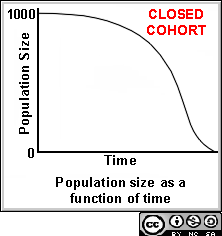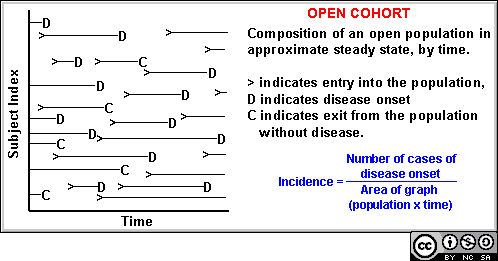 |
| EPI2-8: Closed and Open Populations |
 |
| EPI2-8: Closed and Open Populations |
OBJECTIVES |
|
At the end of this session you should understand the meaning of closed and open populations, how they are constituted and observed and which measures of occurrence are appropriate to use in studies of closed and open populations. |
 The example we have been using up to now is of a closed population which remains at work and observable in a factory across all 10 years of follow up. By closed population is meant a cohort or group of people who all started out together and were observed from that starting point across time for the development of some health-related condition. After the start of observation, no new people enter the cohort or group, and it is hoped that all of the members of the group can be followed up to the end of the time period. In the graph shown on the right, 1000 people start off being observed at a point in time and are followed to their deaths over time.
The example we have been using up to now is of a closed population which remains at work and observable in a factory across all 10 years of follow up. By closed population is meant a cohort or group of people who all started out together and were observed from that starting point across time for the development of some health-related condition. After the start of observation, no new people enter the cohort or group, and it is hoped that all of the members of the group can be followed up to the end of the time period. In the graph shown on the right, 1000 people start off being observed at a point in time and are followed to their deaths over time.

This as we know is unrealistic as people come and go, they retire, get ill, leave the job and new workers are hired. Also the economy expands and contracts and different numbers of workers are needed at different times. More typically then we are studying an open population from the beginning of the observation period to the end. Here people enter and leave the observed population at different times all the way through the observation period.
